- Page 1:
RIGOL Programming Guide DS2000 Seri
- Page 4 and 5:
RIGOL Document Overview This manual
- Page 6 and 7:
RIGOL :BUS:DISPlay.................
- Page 8 and 9:
RIGOL :MASK:FAILed.................
- Page 10 and 11:
RIGOL :TIMebase:VERNier............
- Page 13 and 14:
1 SCPI Overview RIGOL 1 SCPI Overvi
- Page 15 and 16:
1 SCPI Overview RIGOL Symbol Descri
- Page 17 and 18:
1 SCPI Overview RIGOL (namely 100 n
- Page 19 and 20:
2 Command System RIGOL 2 Command Sy
- Page 21 and 22:
2 Command System RIGOL :CLEar Synta
- Page 23 and 24:
2 Command System RIGOL :SINGle Synt
- Page 25 and 26:
2 Command System RIGOL :TFORce Synt
- Page 27 and 28:
2 Command System RIGOL IEEE 488.2 C
- Page 29 and 30:
2 Command System RIGOL *ESE Syntax
- Page 31 and 32:
2 Command System RIGOL *ESR Syntax
- Page 33 and 34:
2 Command System RIGOL *OPC Syntax
- Page 35 and 36:
2 Command System RIGOL *SRE Syntax
- Page 37 and 38:
2 Command System RIGOL *STB Syntax
- Page 39 and 40:
2 Command System RIGOL :ACQuire Sub
- Page 41 and 42:
2 Command System RIGOL :ACQuire:MDE
- Page 43 and 44:
2 Command System RIGOL :ACQuire:TYP
- Page 45 and 46:
2 Command System RIGOL :BUS Subsyst
- Page 47 and 48:
2 Command System RIGOL :BUS:DISPlay
- Page 49 and 50:
2 Command System RIGOL :BUS:EVENt S
- Page 51 and 52:
2 Command System RIGOL :BUS:PARalle
- Page 53 and 54:
2 Command System RIGOL :BUS:PARalle
- Page 55 and 56:
2 Command System RIGOL :BUS:PARalle
- Page 57 and 58:
2 Command System RIGOL :BUS:RS232
- Page 59 and 60:
2 Command System RIGOL :BUS:RS232:R
- Page 61 and 62:
2 Command System RIGOL :BUS:RS232:E
- Page 63 and 64:
2 Command System RIGOL :BUS:RS232:B
- Page 65 and 66:
2 Command System RIGOL :BUS:RS232:S
- Page 67 and 68:
2 Command System RIGOL :BUS:RS232:P
- Page 69 and 70:
2 Command System RIGOL :BUS:RS232:T
- Page 71 and 72:
2 Command System RIGOL :BUS:RS232:O
- Page 73 and 74:
2 Command System RIGOL :BUS:IIC:SCL
- Page 75 and 76:
2 Command System RIGOL :BUS:IIC:SDA
- Page 77 and 78:
2 Command System RIGOL :BUS:IIC:OFF
- Page 79 and 80:
2 Command System RIGOL :BUS:SPI:SCL
- Page 81 and 82:
2 Command System RIGOL :BUS:SPI:SCL
- Page 83 and 84:
2 Command System RIGOL :BUS:SPI:SDA
- Page 85 and 86:
2 Command System RIGOL :BUS:SPI:DBI
- Page 87 and 88:
2 Command System RIGOL :BUS:SPI:OFF
- Page 89 and 90:
2 Command System RIGOL :CALCulate:M
- Page 91 and 92:
2 Command System RIGOL :CALCulate:A
- Page 93 and 94:
2 Command System RIGOL :CALCulate:A
- Page 95 and 96:
2 Command System RIGOL :CALCulate:A
- Page 97 and 98:
2 Command System RIGOL :CALCulate:S
- Page 99 and 100:
2 Command System RIGOL :CALCulate:S
- Page 101 and 102:
2 Command System RIGOL :CALCulate:S
- Page 103 and 104:
2 Command System RIGOL :CALCulate:M
- Page 105 and 106:
2 Command System RIGOL :CALCulate:M
- Page 107 and 108:
2 Command System RIGOL :CALCulate:M
- Page 109 and 110:
2 Command System RIGOL :CALCulate:D
- Page 111 and 112:
2 Command System RIGOL :CALCulate:D
- Page 113 and 114:
2 Command System RIGOL :CALCulate:D
- Page 115 and 116:
2 Command System RIGOL :CALCulate:F
- Page 117 and 118:
2 Command System RIGOL :CALCulate:F
- Page 119 and 120:
2 Command System RIGOL :CALCulate:F
- Page 121 and 122:
2 Command System RIGOL :CALCulate:F
- Page 123 and 124:
2 Command System RIGOL :CALCulate:F
- Page 125 and 126:
2 Command System RIGOL :CALCulate:L
- Page 127 and 128:
2 Command System RIGOL :CALCulate:L
- Page 129 and 130:
2 Command System RIGOL :CALCulate:L
- Page 131 and 132:
2 Command System RIGOL :CALCulate:L
- Page 133 and 134:
2 Command System RIGOL :CALCulate:L
- Page 135 and 136:
2 Command System RIGOL :CALCulate:A
- Page 137 and 138:
2 Command System RIGOL :CALCulate:A
- Page 139 and 140:
2 Command System RIGOL :CALCulate:A
- Page 141 and 142:
2 Command System RIGOL :CALibrate S
- Page 143 and 144:
2 Command System RIGOL :CALibrate:S
- Page 145 and 146:
2 Command System RIGOL :CALibrate:Q
- Page 147 and 148:
2 Command System RIGOL :CHANnel:BWL
- Page 149 and 150:
2 Command System RIGOL :CHANnel:DIS
- Page 151 and 152:
2 Command System RIGOL :CHANnel:OFF
- Page 153 and 154:
2 Command System RIGOL :CHANnel:PRO
- Page 155 and 156:
2 Command System RIGOL :CHANnel:VER
- Page 157 and 158:
2 Command System RIGOL :CURSor:MODE
- Page 159 and 160:
2 Command System RIGOL :CURSor:MANu
- Page 161 and 162:
2 Command System RIGOL :CURSor:MANu
- Page 163 and 164:
2 Command System RIGOL :CURSor:MANu
- Page 165 and 166:
2 Command System RIGOL :CURSor:MANu
- Page 167 and 168:
2 Command System RIGOL :CURSor:MANu
- Page 169 and 170:
2 Command System RIGOL :CURSor:MANu
- Page 171 and 172:
2 Command System RIGOL :CURSor:MANu
- Page 173 and 174:
2 Command System RIGOL :CURSor:MANu
- Page 175 and 176:
2 Command System RIGOL :CURSor:TRAC
- Page 177 and 178:
2 Command System RIGOL :CURSor:TRAC
- Page 179 and 180:
2 Command System RIGOL :CURSor:TRAC
- Page 181 and 182:
2 Command System RIGOL :CURSor:TRAC
- Page 183 and 184:
2 Command System RIGOL :CURSor:TRAC
- Page 185 and 186:
2 Command System RIGOL :CURSor:TRAC
- Page 187 and 188:
2 Command System RIGOL :CURSor:TRAC
- Page 189 and 190:
2 Command System RIGOL :DISPlay:CLE
- Page 191 and 192:
2 Command System RIGOL :DISPlay:GRA
- Page 193 and 194:
2 Command System RIGOL :DISPlay:GRI
- Page 195 and 196:
2 Command System RIGOL :DISPlay:MPE
- Page 197 and 198:
2 Command System RIGOL Note [2] : t
- Page 199 and 200:
2 Command System RIGOL :FUNCtion Su
- Page 201 and 202:
2 Command System RIGOL :FUNCtion:WR
- Page 203 and 204:
2 Command System RIGOL :FUNCtion:WR
- Page 205 and 206:
2 Command System RIGOL :FUNCtion:WR
- Page 207 and 208:
2 Command System RIGOL :FUNCtion:WR
- Page 209 and 210:
2 Command System RIGOL :FUNCtion:WR
- Page 211 and 212:
2 Command System RIGOL :FUNCtion:WR
- Page 213 and 214:
2 Command System RIGOL :FUNCtion:WR
- Page 215 and 216:
2 Command System RIGOL :FUNCtion:WR
- Page 217 and 218:
2 Command System RIGOL :FUNCtion:WA
- Page 219 and 220:
2 Command System RIGOL :FUNCtion:WA
- Page 221 and 222:
2 Command System RIGOL :FUNCtion:WA
- Page 223 and 224:
2 Command System RIGOL :FUNCtion:WA
- Page 225 and 226:
2 Command System RIGOL :FUNCtion:WA
- Page 227 and 228:
2 Command System RIGOL :FUNCtion:WA
- Page 229 and 230:
2 Command System RIGOL :FUNCtion:WA
- Page 231 and 232:
2 Command System RIGOL :FUNCtion:WA
- Page 233 and 234:
2 Command System RIGOL :FUNCtion:WA
- Page 235 and 236:
2 Command System RIGOL :FUNCtion:WA
- Page 237 and 238:
2 Command System RIGOL :LAN:DHCP Sy
- Page 239 and 240:
2 Command System RIGOL :LAN:GATeway
- Page 241 and 242:
2 Command System RIGOL :LAN:MAC Syn
- Page 243 and 244:
2 Command System RIGOL :LAN:INITiat
- Page 245 and 246:
2 Command System RIGOL :LAN:SMASk S
- Page 247 and 248:
2 Command System RIGOL :LAN:VISA Sy
- Page 249 and 250:
2 Command System RIGOL :MASK Subsys
- Page 251 and 252:
2 Command System RIGOL :MASK:SOURce
- Page 253 and 254:
2 Command System RIGOL :MASK:MDISpl
- Page 255 and 256:
2 Command System RIGOL :MASK:OUTPut
- Page 257 and 258:
2 Command System RIGOL :MASK:Y Synt
- Page 259 and 260:
2 Command System RIGOL :MASK:PASSed
- Page 261 and 262:
2 Command System RIGOL :MASK:TOTal
- Page 263 and 264:
2 Command System RIGOL :MASK:DATA S
- Page 265 and 266:
2 Command System RIGOL • :MEASure
- Page 267 and 268:
2 Command System RIGOL :MEASure:COU
- Page 269 and 270:
2 Command System RIGOL :MEASure:CLE
- Page 271 and 272:
2 Command System RIGOL :MEASure:ADI
- Page 273 and 274:
2 Command System RIGOL :MEASure:STA
- Page 275 and 276:
2 Command System RIGOL :MEASure:STA
- Page 277 and 278:
2 Command System RIGOL :MEASure:SET
- Page 279 and 280:
2 Command System RIGOL :MEASure:SET
- Page 281 and 282:
2 Command System RIGOL :MEASure:CRE
- Page 283 and 284:
2 Command System RIGOL :MEASure:HIS
- Page 285 and 286:
2 Command System RIGOL :MEASure:FDE
- Page 287 and 288:
2 Command System RIGOL :MEASure:FDE
- Page 289 and 290:
2 Command System RIGOL :MEASure:FDE
- Page 291 and 292:
2 Command System RIGOL :MEASure:FPH
- Page 293 and 294:
2 Command System RIGOL :MEASure:FPH
- Page 295 and 296:
2 Command System RIGOL :MEASure:FPH
- Page 297 and 298:
2 Command System RIGOL :MEASure:FRE
- Page 299 and 300:
2 Command System RIGOL :MEASure:FRE
- Page 301 and 302:
2 Command System RIGOL :MEASure:FRE
- Page 303 and 304:
2 Command System RIGOL :MEASure:FTI
- Page 305 and 306:
2 Command System RIGOL :MEASure:FTI
- Page 307 and 308:
2 Command System RIGOL :MEASure:FTI
- Page 309 and 310:
2 Command System RIGOL :MEASure:NDU
- Page 311 and 312:
2 Command System RIGOL :MEASure:NDU
- Page 313 and 314:
2 Command System RIGOL :MEASure:NDU
- Page 315 and 316:
2 Command System RIGOL :MEASure:NWI
- Page 317 and 318:
2 Command System RIGOL :MEASure:NWI
- Page 319 and 320:
2 Command System RIGOL :MEASure:NWI
- Page 321 and 322:
2 Command System RIGOL :MEASure:OVE
- Page 323 and 324:
2 Command System RIGOL :MEASure:OVE
- Page 325 and 326:
2 Command System RIGOL :MEASure:OVE
- Page 327 and 328:
2 Command System RIGOL :MEASure:PDU
- Page 329 and 330:
2 Command System RIGOL :MEASure:PDU
- Page 331 and 332:
2 Command System RIGOL :MEASure:PDU
- Page 333 and 334:
2 Command System RIGOL :MEASure:PER
- Page 335 and 336:
2 Command System RIGOL :MEASure:PER
- Page 337 and 338:
2 Command System RIGOL :MEASure:PER
- Page 339 and 340:
2 Command System RIGOL :MEASure:PRE
- Page 341 and 342:
2 Command System RIGOL :MEASure:PRE
- Page 343 and 344:
2 Command System RIGOL :MEASure:PRE
- Page 345 and 346:
2 Command System RIGOL :MEASure:PWI
- Page 347 and 348:
2 Command System RIGOL :MEASure:PWI
- Page 349 and 350:
2 Command System RIGOL :MEASure:PWI
- Page 351 and 352:
2 Command System RIGOL :MEASure:RTI
- Page 353 and 354:
2 Command System RIGOL :MEASure:RTI
- Page 355 and 356:
2 Command System RIGOL :MEASure:RTI
- Page 357 and 358:
2 Command System RIGOL :MEASure:RDE
- Page 359 and 360:
2 Command System RIGOL :MEASure:RDE
- Page 361 and 362:
2 Command System RIGOL :MEASure:RDE
- Page 363 and 364:
2 Command System RIGOL :MEASure:RPH
- Page 365 and 366:
2 Command System RIGOL :MEASure:RPH
- Page 367 and 368:
2 Command System RIGOL :MEASure:RPH
- Page 369 and 370:
2 Command System RIGOL :MEASure:VAM
- Page 371 and 372:
2 Command System RIGOL :MEASure:VAM
- Page 373 and 374:
2 Command System RIGOL :MEASure:VAM
- Page 375 and 376:
2 Command System RIGOL :MEASure:VAV
- Page 377 and 378:
2 Command System RIGOL :MEASure:VAV
- Page 379 and 380:
2 Command System RIGOL :MEASure:VAV
- Page 381 and 382:
2 Command System RIGOL :MEASure:VBA
- Page 383 and 384:
2 Command System RIGOL :MEASure:VBA
- Page 385 and 386:
2 Command System RIGOL :MEASure:VBA
- Page 387 and 388:
2 Command System RIGOL :MEASure:VMA
- Page 389 and 390:
2 Command System RIGOL :MEASure:VMA
- Page 391 and 392:
2 Command System RIGOL :MEASure:VMA
- Page 393 and 394:
2 Command System RIGOL :MEASure:VMI
- Page 395 and 396:
2 Command System RIGOL :MEASure:VMI
- Page 397 and 398:
2 Command System RIGOL :MEASure:VMI
- Page 399 and 400:
2 Command System RIGOL :MEASure:VPP
- Page 401 and 402:
2 Command System RIGOL :MEASure:VPP
- Page 403 and 404:
2 Command System RIGOL :MEASure:VPP
- Page 405 and 406:
2 Command System RIGOL :MEASure:VRM
- Page 407 and 408:
2 Command System RIGOL :MEASure:VRM
- Page 409 and 410:
2 Command System RIGOL :MEASure:VRM
- Page 411 and 412:
2 Command System RIGOL :MEASure:VTO
- Page 413 and 414:
2 Command System RIGOL :MEASure:VTO
- Page 415 and 416:
2 Command System RIGOL :MEASure:VTO
- Page 417 and 418:
2 Command System RIGOL :SYSTem Subs
- Page 419 and 420:
2 Command System RIGOL :SYSTem:DATE
- Page 421 and 422:
2 Command System RIGOL :SYSTem:ERRo
- Page 423 and 424:
2 Command System RIGOL :SYSTem:LANG
- Page 425 and 426:
2 Command System RIGOL :SYSTem:SSAV
- Page 427 and 428:
2 Command System RIGOL :SYSTem:VERS
- Page 429 and 430:
2 Command System RIGOL :SYSTem:RESe
- Page 431 and 432:
2 Command System RIGOL :SYSTem:OPTi
- Page 433 and 434:
2 Command System RIGOL :SYSTem:GPIB
- Page 435 and 436:
2 Command System RIGOL :SYSTem:RAMo
- Page 437 and 438:
2 Command System RIGOL :TIMebase:DE
- Page 439 and 440:
2 Command System RIGOL :TIMebase:DE
- Page 441 and 442:
2 Command System RIGOL :TIMebase[:M
- Page 443 and 444:
2 Command System RIGOL :TIMebase:HR
- Page 445 and 446:
2 Command System RIGOL :TIMebase:VE
- Page 447 and 448:
2 Command System RIGOL :TRIGger:MOD
- Page 449 and 450:
2 Command System RIGOL :TRIGger:STA
- Page 451 and 452:
2 Command System RIGOL :TRIGger:HOL
- Page 453 and 454:
2 Command System RIGOL :TRIGger:EDG
- Page 455 and 456:
2 Command System RIGOL :TRIGger:EDG
- Page 457 and 458:
2 Command System RIGOL :TRIGger:PUL
- Page 459 and 460:
2 Command System RIGOL :TRIGger:PUL
- Page 461 and 462:
2 Command System RIGOL :TRIGger:PUL
- Page 463 and 464:
2 Command System RIGOL :TRIGger:PUL
- Page 465 and 466:
2 Command System RIGOL :TRIGger:RUN
- Page 467 and 468:
2 Command System RIGOL :TRIGger:RUN
- Page 469 and 470:
2 Command System RIGOL :TRIGger:RUN
- Page 471 and 472:
2 Command System RIGOL :TRIGger:RUN
- Page 473 and 474:
2 Command System RIGOL :TRIGger:WIN
- Page 475 and 476:
2 Command System RIGOL :TRIGger:WIN
- Page 477 and 478:
2 Command System RIGOL :TRIGger:NED
- Page 479 and 480:
2 Command System RIGOL :TRIGger:NED
- Page 481 and 482:
2 Command System RIGOL :TRIGger:NED
- Page 483 and 484:
2 Command System RIGOL :TRIGger:SLO
- Page 485 and 486:
2 Command System RIGOL :TRIGger:SLO
- Page 487 and 488:
2 Command System RIGOL :TRIGger:SLO
- Page 489 and 490:
2 Command System RIGOL :TRIGger:SLO
- Page 491 and 492:
2 Command System RIGOL :TRIGger:SLO
- Page 493 and 494:
2 Command System RIGOL :TRIGger:VID
- Page 495 and 496:
2 Command System RIGOL :TRIGger:VID
- Page 497 and 498:
2 Command System RIGOL :TRIGger:VID
- Page 499 and 500:
2 Command System RIGOL :TRIGger:PAT
- Page 501 and 502:
2 Command System RIGOL :TRIGger:PAT
- Page 503 and 504:
2 Command System RIGOL :TRIGger:DEL
- Page 505 and 506:
2 Command System RIGOL :TRIGger:DEL
- Page 507 and 508:
2 Command System RIGOL :TRIGger:DEL
- Page 509 and 510:
2 Command System RIGOL :TRIGger:DEL
- Page 511 and 512:
2 Command System RIGOL :TRIGger:TIM
- Page 513 and 514:
2 Command System RIGOL :TRIGger:TIM
- Page 515 and 516:
2 Command System RIGOL :TRIGger:DUR
- Page 517 and 518:
2 Command System RIGOL :TRIGger:DUR
- Page 519 and 520:
2 Command System RIGOL :TRIGger:DUR
- Page 521 and 522:
2 Command System RIGOL :TRIGger:SHO
- Page 523 and 524:
2 Command System RIGOL :TRIGger:SHO
- Page 525 and 526:
2 Command System RIGOL :TRIGger:SHO
- Page 527 and 528:
2 Command System RIGOL :TRIGger:SHO
- Page 529 and 530:
2 Command System RIGOL :TRIGger:RS2
- Page 531 and 532:
2 Command System RIGOL :TRIGger:RS2
- Page 533 and 534:
2 Command System RIGOL :TRIGger:RS2
- Page 535 and 536:
2 Command System RIGOL :TRIGger:RS2
- Page 537 and 538:
2 Command System RIGOL :TRIGger:RS2
- Page 539 and 540:
2 Command System RIGOL :TRIGger:IIC
- Page 541 and 542:
2 Command System RIGOL :TRIGger:IIC
- Page 543 and 544:
2 Command System RIGOL :TRIGger:IIC
- Page 545 and 546:
2 Command System RIGOL :TRIGger:IIC
- Page 547 and 548:
2 Command System RIGOL :TRIGger:IIC
- Page 549 and 550:
2 Command System RIGOL :TRIGger:SPI
- Page 551 and 552:
2 Command System RIGOL :TRIGger:SPI
- Page 553 and 554:
2 Command System RIGOL :TRIGger:SPI
- Page 555 and 556: 2 Command System RIGOL :TRIGger:SPI
- Page 557 and 558: 2 Command System RIGOL :TRIGger:SPI
- Page 559 and 560: 2 Command System RIGOL :TRIGger:USB
- Page 561 and 562: 2 Command System RIGOL :TRIGger:USB
- Page 563 and 564: 2 Command System RIGOL :TRIGger:USB
- Page 565 and 566: 2 Command System RIGOL :WAVeform Su
- Page 567 and 568: 2 Command System RIGOL :WAVeform:MO
- Page 569 and 570: 2 Command System RIGOL :WAVeform:PO
- Page 571 and 572: 2 Command System RIGOL visa32.viPri
- Page 573 and 574: 2 Command System RIGOL Note: when t
- Page 575 and 576: 2 Command System RIGOL if (strBuild
- Page 577 and 578: 2 Command System RIGOL Int32 viRetC
- Page 579 and 580: 2 Command System RIGOL :WAVeform:XO
- Page 581 and 582: 2 Command System RIGOL :WAVeform:YI
- Page 583 and 584: 2 Command System RIGOL :WAVeform:YR
- Page 585 and 586: 2 Command System RIGOL :WAVeform:ST
- Page 587 and 588: 2 Command System RIGOL :WAVeform:EN
- Page 589 and 590: 2 Command System RIGOL :WAVeform:PR
- Page 591 and 592: 3 Programming Demos RIGOL 3 Program
- Page 593 and 594: 3 Programming Demos RIGOL Programmi
- Page 595 and 596: 3 Programming Demos RIGOL 5. C# pro
- Page 597 and 598: 3 Programming Demos RIGOL Excel Pro
- Page 599 and 600: 3 Programming Demos RIGOL 4. Turn o
- Page 601 and 602: 3 Programming Demos RIGOL 9. Add th
- Page 603 and 604: 3 Programming Demos RIGOL Labview P
- Page 605: 3 Programming Demos RIGOL 5. The da
- Page 609 and 610: 3 Programming Demos RIGOL Visual Ba
- Page 611 and 612: 3 Programming Demos RIGOL Label1(0)
- Page 613 and 614: 3 Programming Demos RIGOL 4. Open t
- Page 615 and 616: 3 Programming Demos RIGOL 8. Add co



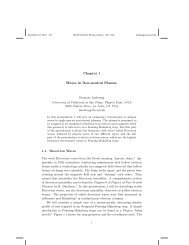
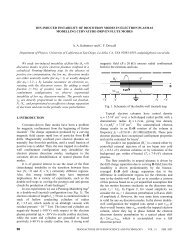
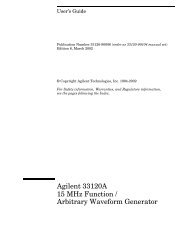

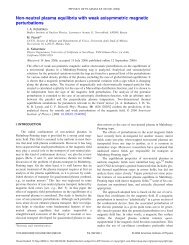
![WORKSHOP PARTICIPANTS LIST [pdf] - UC San Diego](https://img.yumpu.com/35298899/1/190x245/workshop-participants-list-pdf-uc-san-diego.jpg?quality=85)
